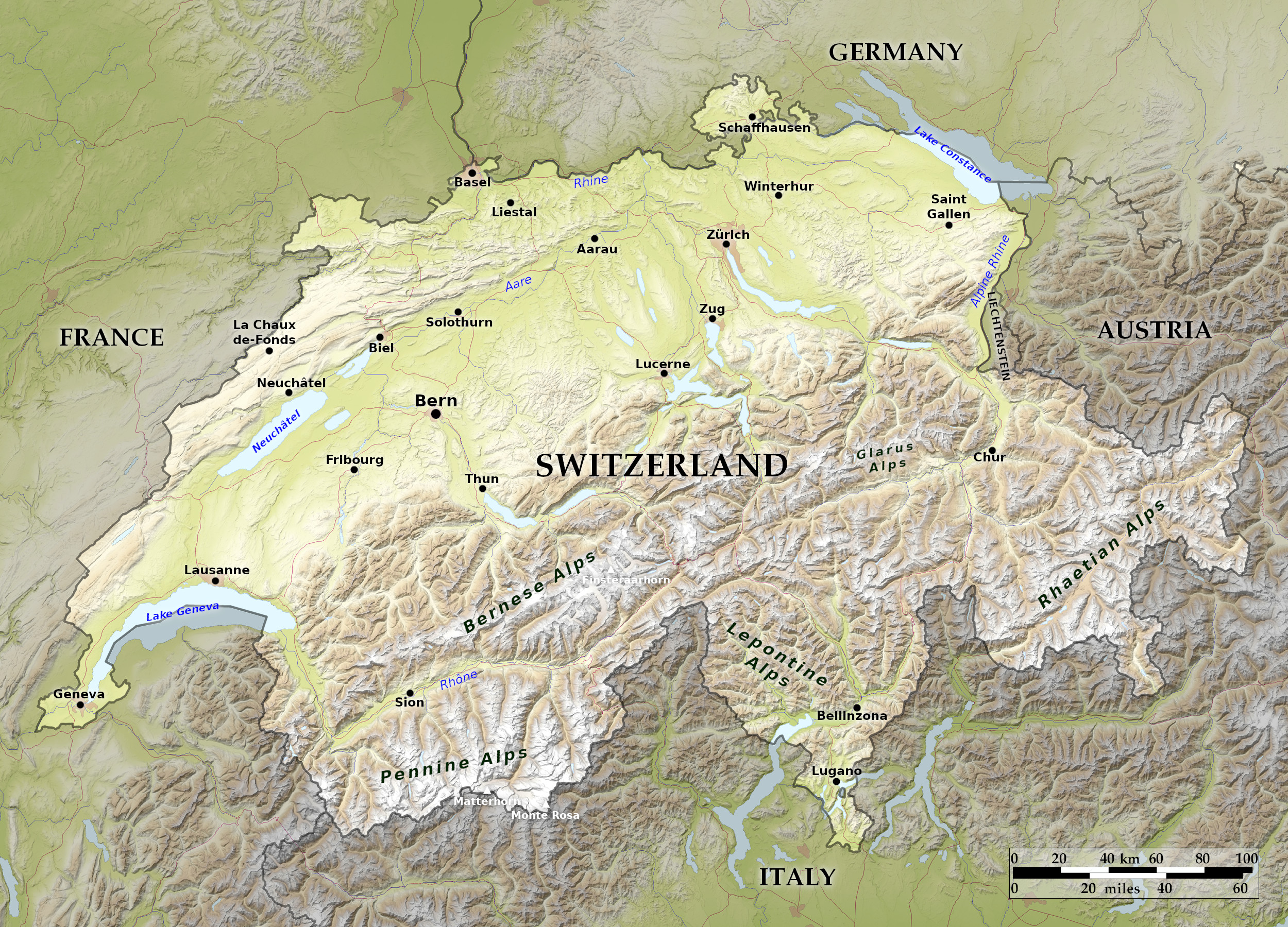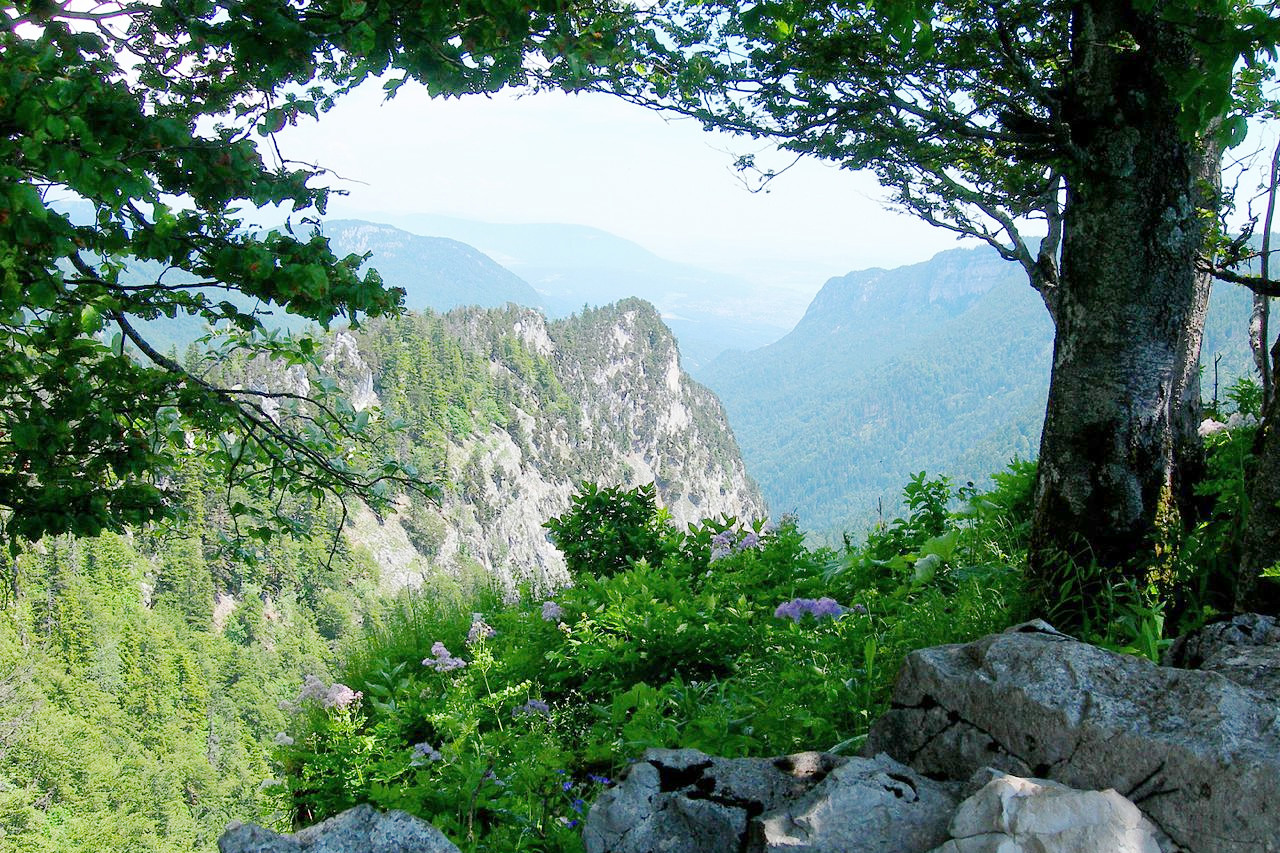The Geography of
Switzerland
Why visit Switzerland?
Switzerland has an unmatched variety of attractions. The Alps, the Swiss lakes, fertile valleys, picturesque old villages, sparkling modern cities, rustic simplicity, have attracted generations of tourists, winter and summer, to this small but vital country. Switzerland enjoys some of the finest mountain landscapes in the world. Its Alps are legendary, its sweeping mountain lakes spectacular, its villages always attractive. The country unites three cultures—French, German, and Italian—reflected in the variety of food, architecture, and traditions you will find in different areas. It is a peaceful, stable country, whose people live surrounded by outstanding natural beauty.
Map
 Relief map of Switzerland
Relief map of Switzerland
What is the landscape of Switzerland like?
Alps
The scenery of the Alps with their high peaks, deep glaciated valleys, forested slopes, gorges, waterfalls, glaciers, and lakes, attracts large numbers of visitors each year. The Swiss Alps form a part of the great curve of the Alpine chain of central Europe; they extend along the southern or Italian frontier for 170 miles, and their windings and spurs fill more than half the country. The average height of the highest chain is around 2,500 meters (8,000 feet). The main subdivisions are the Bernese Alps and Pennine Alps in the west, the Lepontine Alps in the center, and the Glarus Alps and Rhaetian Alps in the east.
Monte Rosa is Switzerland's highest peak at 4,634 meters (15,203 feet); the Matterhorn, the most famous Swiss peak, has a height of 4,478 m (14,692 feet). Everywhere above 3,000 meters (9,800 feet) the mountains are covered with everlasting snow, which descends along the hollows in glaciers to a much lower level, and in this way covers the higher parts of the country with a vast sea of ice. In all, the Alps contain more than one thousand glaciers; the largest is the Aletsch Glacier, which is 23 kilometers (14 miles) long. The subalpine region on the northwest fringe of the Alps has a less complex structure than the main range—there the peaks typically reach heights of about 2,000 meters (6,500 feet).
Mittelland
North of the Alps extends the central region (the "Mittelland"), which covers about 30 per cent of the entire area of Switzerland. This is Switzerland's central plateau, and includes slightly rolling hills, meadowlands, and winding valleys. There are very many beautiful lakes, large and small. The two most extensive, those of Geneva and of Constance, balance each other, as it were, at the southwest and northeast corners of the country.
Jura
In northwest Switzerland rise the Jura Mountains on the French border. The Jura range is a huge plateau about 150 miles long, hewn into an oblong shape. It consists of a series of parallel ridges shutting in long and narrow valleys; and raised to an average height of from 600 to 800 meters (1,950–2,600 feet) above the surrounding plains. The ridges are forested but the intervening valleys contain areas of rich meadow land used as summer pastures. It is in the Jura region that the great centers of the Swiss watch-making industry were concentrated.
What is the nature of Switzerland like?
Forests cover 38% of the total area of Switzerland, and the differences in altitude means that a vast swathe of different vegetation can be found in the country. Olives in a few of the low valleys are succeeded by vines and the plants of central Europe; then come in succession deciduous trees, conifers, the high pastures, and shrubs and mosses, above which rises the region of perpetual snow.
Oaks and chestnut trees are abundant only in the more southern valleys, beech trees are numerous up to 1,200 meters (4,000 feet) above sea-level, and pines, larches, and fir trees thrive between 1,200 and 2,000 meters (4,000–6,500 feet).
What is the climate of Switzerland like?
See our main article: The Climate of Switzerland
The climate of Switzerland is conditioned by the Alps. The lowlands have warm, pleasant summers, while the mountains are cooler at high altitudes but hotter in the valleys. In autumn and winter, fog is common at lower altitudes, while the higher altitudes enjoy dry, sunny weather. Rainfall increases with altitude; the higher the elevation, the greater chance that it falls as snow. At Alpine altitudes of greater than 3,500 meters (11,500 feet), it always falls as snow.
| Climate data for Bern (1991–2020) | |||||||||||||
|---|---|---|---|---|---|---|---|---|---|---|---|---|---|
| Month | Jan | Feb | Mar | Apr | May | Jun | Jul | Aug | Sep | Oct | Nov | Dec | Year |
| Average high °C (°F) | 3.4 (38.1) | 5.2 (41.4) | 10.3 (50.5) | 14.5 (58.1) | 18.6 (65.5) | 22.5 (72.5) | 24.6 (76.3) | 24.2 (75.6) | 19.4 (66.9) | 14.0 (57.2) | 7.7 (45.9) | 3.8 (38.8) | 14.0 (57.2) |
| Daily mean °C (°F) | 0.2 (32.4) | 1.1 (34.0) | 5.2 (41.4) | 9.0 (48.2) | 13.2 (55.8) | 16.9 (62.4) | 18.8 (65.8) | 18.4 (65.1) | 14.1 (57.4) | 9.5 (49.1) | 4.2 (39.6) | 0.9 (33.6) | 9.3 (48.7) |
| Average low °C (°F) | −2.9 (26.8) | −2.8 (27.0) | 0.3 (32.5) | 3.4 (38.1) | 7.6 (45.7) | 11.3 (52.3) | 13.0 (55.4) | 12.9 (55.2) | 9.2 (48.6) | 5.5 (41.9) | 1.0 (33.8) | −2.1 (28.2) | 4.7 (40.5) |
| Average precipitation mm (inches) | 60 (2.4) | 56 (2.2) | 65 (2.6) | 78 (3.1) | 112 (4.4) | 102 (4.0) | 108 (4.3) | 112 (4.4) | 87 (3.4) | 86 (3.4) | 77 (3.0) | 78 (3.1) | 1,022 (40.2) |
| Average snowfall cm (inches) | 11 (4.3) | 11 (4.3) | 5 (2.0) | 1 (0.4) | 0 (0) | 0 (0) | 0 (0) | 0 (0) | 0 (0) | 0 (0) | 5 (2.0) | 14 (5.5) | 47 (19) |
| Source: MeteoSwiss | |||||||||||||
 Baltschiedertal, in the Bernese Alps
Baltschiedertal, in the Bernese Alps
The official websites
Switzerland

Switzerland, get natural
| Location: | Central Europe |
| Coordinates: | 46° 45′ N, 08° 15′ E |
| Size: | • 220 km N-S; 345 km E-W • 135 miles N-S; 215 miles E-W |
| Terrain: | Mountainous with various branches of the Alps extending over the south; lowlands and hills in the north |
| Climate: | Warm, and even hot summers in the lowlands and valleys. Cold winters with snow at altitude |
| Highest point: | Monte Rosa 4,634 m / 15,203 ft |
| Forest: | 38% (2010 est.) (source) |
| Population: | 8,570,146 (2019) |
| Population density: | High (207/km²) |
| Capital: | Bern (de facto) |
| Languages: | German, French, Italian, Romansh |
| Human Development Index: | Very High (0.955) |
| Currency: | Swiss franc |




